The Construction Act – A New Era for Ontario’s Construction Industry

WHAT HAPPENED?
Major change has come. On December 12, 2017, the Construction Lien Act Amendment Act, 2017 (Bill 142) received Royal Assent, and the act formerly known as the Construction Lien Act has had its first major overhaul since 1983. The new legislation is known as the Construction Act. The Construction Act brings in an entirely new era for the construction industry. The intent behind the changes is three-fold:
- to modernize a key piece of legislation that had not had any major revision for 35 years;
- to introduce a mandatory prompt payment regime to make cash flow to all parties more readily; and
- to implement a mandatory adjudication process to speed up dispute resolution process to reduce the cost of complicated and lengthy disputes.
Several important changes will take effect very shortly but at different times, and these sweeping amendments will impact all construction work and projects in Ontario, including everything from mining to real estate development.
WHO NEEDS TO KNOW?
Everyone. Nearly everything has been dramatically modified to some degree, from liens and holdbacks to the timing of payments and dispute resolution. It is such a profound change that even other provinces are looking very closely at this new piece of legislation, especially prompt payment and adjudication, as many of them anticipate that they will have to follow suit. It is thus crucial that all those at all affiliated with the construction industry take notice and fully understand what the new state of the law is, when it comes into effect, and how to remain in compliance with it throughout the transition period.
WHEN DOES ALL OF THIS HAPPEN?
While some minor changes were effective immediately in December of 2017, the vast majority of the changes will be in force on July 1, 2018. However, be aware that the new prompt payment regime and adjudication changes will take effect on October 1, 2019.
WHAT MATTERS?
Everyone’s interests will be affected, but how they will be impacted depends very much on your specific role and how it relates to the construction industry. While discussion of the full breadth of the changes is beyond the scope of one article, here are a few key takeaways most people should be aware of:
CHECK YOUR UNDERSTANDING OF KEY TERMS – There are New Definitions Throughout
Many definitions have been updated or replaced to better reflect modern project structures. For example:
- With “exaggerated liens” a lien claimant can now be held liable for false or exaggerated claims if the claim is willfully exaggerated, instead of just grossly, and the courts can now discharge frivolous liens directly.
- “Substantial performance” now increases to 3% of the first $1,000,000 of the contract price, rather than the previous $500,000.
- A contract will now be deemed “completed” at an earlier stage as the threshold will be increased to the lesser of 1% or $5,000 of the contract price, rather than the previous $1,000.
- The “minor errors” in a claim for lien that a court can rectify is expanded.
- Many other terms have been updated as well such as: “improvement”, “owner”, “contractor”, “price”, “subcontractor”, “broader public-sector organization”, and “municipality”.
NEW TIMELINES – Construction Lien & Holdback Rules
There are new rules relating to the timing of liens which come into effect on July 1, 2018. However, fear not! For existing projects, section 87.3 grandfathers the old procedure and the new provisions will only apply to contracts and procurements started after July 1, 2018. However, for new contracts signed after July 1, 2018, that were not part of a procurement process, the new timing is as follows:
- the period to preserve a lien will be increased to 60 days instead of 45 from the last supply of materials or services;
- preserved liens must be perfected by starting an action within 90 days, instead of 45;
- holdback is released 45 days after substantial completion of the work.
Note: if there was a procurement process started in June 2018 and the contract is signed in August, the lien period will remain 45 days and all the other provisions of the old act continue to apply.
The requisite holdback will remain at 10% of the value of the improvement, but security can now be offered in the form of a holdback bond or letter of credit, instead of cash alone. Further, the release of holdbacks can now be paid in two ways:
- on an annual basis for longer term projects, if the project is over $20 million and the early release of holdback is set out in the contract; or
- on a phased basis, for projects with different stages of completion.
STREAMLINED ACCOUNTING: No Project-Specific Bank Accounts, but Separate Record Keeping
There is now a requirement to keep separate accounting records of contract payments received for each project, unless the proceeds are kept in a separate bank account. There are also special new rules to deal with trust funds specifically.
- New Rules for Trust Funds: While no separate bank account is needed for every trust fund, on all new projects after July 1, 2018, the holder of those funds must keep records for those funds as though they were segregated. Bear in mind it is still best to maintain a separate bank account in terms of best practices, but it isn’t necessary.
- Set offs against trust funds will be permitted, but this has been narrowed to the project at hand; only amounts owed and liabilities on the same improvement can be set off, unless there is a bankruptcy.
NEW STEPS IN COURT: Updated Claims Procedure
The construction claims process gains more flexibility with the new amendments. The Construction Act allows a party to combine liens, trusts, and contract dispute claims without requiring leave of the court. The general powers of the court to remove a lien and dismiss an action have also been made more specific. For example:
- motions will no longer need leave;
- construction claims will be subject to case management;
- liens for under $25,000 can be heard in Small Claims Court;
- interlocutory orders may now be appealed with leave; and
- there is no right to appeal from orders for less than $10,000.
The change for appeals is significant – a party used to only be able to appeal from final orders and was barred from appealing interlocutory orders. Now a party can also appeal interlocutory orders with leave, and a final order can still be appealed to the divisional court without leave.
LANDLORDS HAVE ENHANCED LIEN EXPOSURE – New Rights and Obligations re Tenant Improvements
Contractors performing work on tenant improvements, that are “funded” by the landlord, will now have an automatic lien right against the landlord’s fee simple interest in the land. This means that Landlords who pay for a tenant’s improvements now have a lien exposure to the extent of 10% of the value of the improvements. The term “fund” is given significantly broader meaning as well. Additionally, Landlords now also have to answer requests for information, and the type of information that can be requested of them has also expanded.
AN ENTIRELY NEW REGIME: A Mandatory Prompt Payment Regime begins October 2019– s 6.1
Bill 142 introduces a strict “prompt payment” regime that is mandatory for all contracts and that applies to both private and public-sector projects, all parties in the construction pyramid, and all sizes and types of improvements. Key points to consider are:
- Timing Matters: Owners will have 28 days to pay a contractor after delivery of a proper invoice, and contractors will have 7 days to pay a sub-contractor (after getting paid by the owner).
- There will be some flexibility: Parties will be permitted to establish payment schedules or payment structures through a clear contract, thus they do not have to be based on monthly progress payments, but the calculation of the 28-day period starts once an invoice is submitted in accordance with their payment structure.
- Agreement matters: The owner and general contractor will be able to agree on some details for the submittal of an invoice but where they disagree, monthly invoices will be required.
- Notice of Non-Payment is Required: Owners can dispute all or parts of an invoice, but owners will now be required to deliver a notice of non-payment within 14 days of receiving the proper invoice from the contractor, which must set out all of the owner’s reasons for not paying. Similarly, contractors must also deliver a notice of non-payment to subcontractors (and subcontractors to sub-subcontractors) if they do not intend to pay the full amount of the invoice.
- If an owner pays, the contractor will need to deliver the notice of non-payment to that subcontractor within 7 days.
- If the owner does not pay any part of the contractor’s proper invoice, the contractor has 35 days to deliver the notice of non-payment to its subcontractors.
CAUTION: While a contractor must pay subcontractors within 7 days of getting paid by the owner, if an owner has not paid, then within 35 days of sending in the proper invoice, a contractor must either commence an adjudication against the owner or pay the subcontractor directly (unless it has delivered a notice of non-payment). This gives contractors, who want to avoid a dispute with the owner, an opportunity to pay the subcontractor out of their own pocket if they so choose.
Other Change Key Changes:
- Contractors of public projects must now supply labour and material payment bonds, unless expressly exempted by the regulations.
- There are now over 18 standard prescribed forms required under the Act for various steps.
- All municipal property will be liened by notice instead or registration, and not just roads. There is also a re-enactment of the provision stating that liens do not attach to premises of a municipality, as well as Crown.
- Termination of contracts will now also require the publication of formal notice.
- The amount of security for costs that must be posted to vacate a lien has also increased.
WHAT DO I DO NOW?
Let’s get you prepared. Get informed about your specific legal obligations now. This is not the time to wait and let others take the lead. Seek legal advice early to avoid costly mistakes as this new era unfolds. Our construction and real estate teams, with over 30 years of experience, are fully informed and ready to help you navigate even the most complex of these changes in a timely and effective manner. With our help, you will find your strongest position in Ontario’s new construction and development market. Do not hesitate to call us today to set up a consultation.
Want to take a look yourself? You can get your own copy of Bill 142 here.
| Shawn O’Connor | Allison Russell | Kate Agyemang, Articling Student |
 |
 |
 |



